engine overheat MITSUBISHI GRANDIS 2008 Owner's Manual (in English)
[x] Cancel search | Manufacturer: MITSUBISHI, Model Year: 2008, Model line: GRANDIS, Model: MITSUBISHI GRANDIS 2008Pages: 458, PDF Size: 18.52 MB
Page 132 of 458

3-6 Instruments and controls
3
Low fuel warning lamp
E00508100638
The warning lamp (A) comes on when the fuel level is getting
low (approx. 10 liters) with the ignition switch in the “ON”
position. Refuel as soon as possible.NOTE●On inclines or curves, due to the movement of fuel in the
tank, the low fuel warning lamp may indicate incorrectly.
Water temperature gauge
E00500800118
The water temperature gauge indicates the engine coolant tem-
perature when the ignition switch is “ON”.
CAUTION
!●If the indication needle enters the zone (A) while the
engine is running, it indicates that the engine is pos-
sibly overheating. Immediately park your vehicle in
a safe place and make the necessary corrections.
(Refer to “Engine overheating” on page 6-7.)
While driving, care should always be taken to main-
tain the normal operating temperature.
BK-XP08E1ENUK.en-uk.book Page 6 Monday, August 13, 2007 2:20 PM
Page 201 of 458
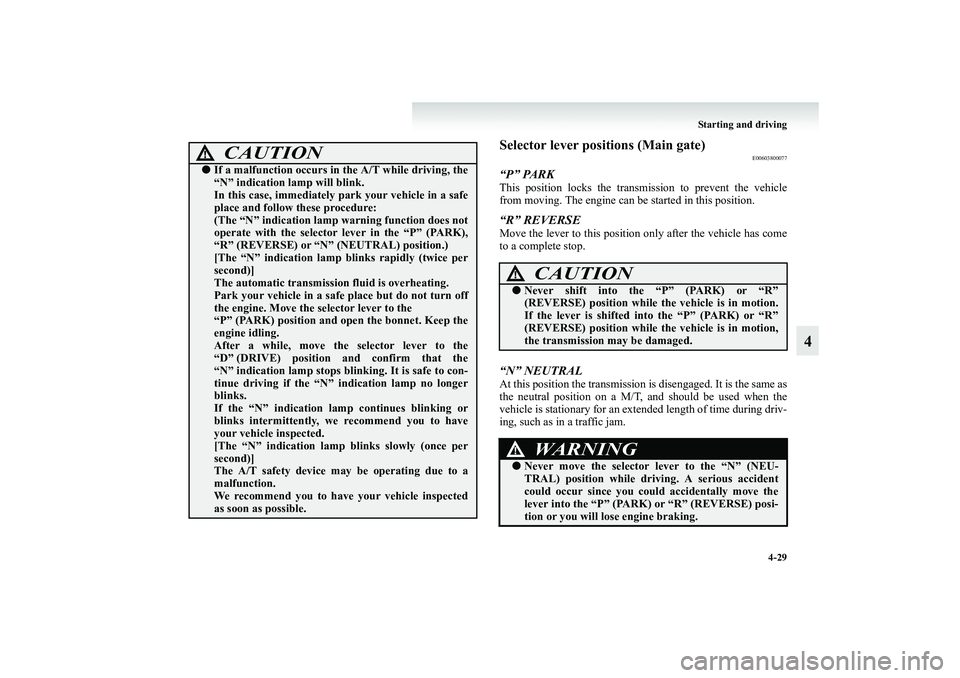
Starting and driving
4-29
4
Selector lever positions (Main gate)
E00603800077
“P” PARKThis position locks the transmission to prevent the vehicle
from moving. The engine can be started in this position.“R” REVERSEMove the lever to this position only after the vehicle has come
to a complete stop.“N” NEUTRALAt this position the transmission is disengaged. It is the same as
the neutral position on a M/T, and should be used when the
vehicle is stationary for an extended length of time during driv-
ing, such as in a traffic jam.
CAUTION
!●If a malfunction occurs in the A/T while driving, the
“N” indication lamp will blink.
In this case, immediately park your vehicle in a safe
place and follow these procedure:
(The “N” indication lamp warning function does not
operate with the selector lever in the “P” (PARK),
“R” (REVERSE) or “N” (NEUTRAL) position.)
[The “N” indication lamp blinks rapidly (twice per
second)]
The automatic transmission fluid is overheating.
Park your vehicle in a safe place but do not turn off
the engine. Move the selector lever to the
“P” (PARK) position and open the bonnet. Keep the
engine idling.
After a while, move the selector lever to the
“D” (DRIVE) position and confirm that the
“N” indication lamp stops blinking. It is safe to con-
tinue driving if the “N” indication lamp no longer
blinks.
If the “N” indication lamp continues blinking or
blinks intermittently, we recommend you to have
your vehicle inspected.
[The “N” indication lamp blinks slowly (once per
second)]
The A/T safety device may be operating due to a
malfunction.
We recommend you to have your vehicle inspected
as soon as possible.
CAUTION
!●Never shift into the “P” (PARK) or “R”
(REVERSE) position while the vehicle is in motion.
If the lever is shifted into the “P” (PARK) or “R”
(REVERSE) position while the vehicle is in motion,
the transmission may be damaged.
WARNING
!●Never move the selector lever to the “N” (NEU-
TRAL) position while driving. A serious accident
could occur since you could accidentally move the
lever into the “P” (PARK) or “R” (REVERSE) posi-
tion or you will lose engine braking.
BK-XP08E1ENUK.en-uk.book Page 29 Monday, August 13, 2007 2:20 PM
Page 207 of 458
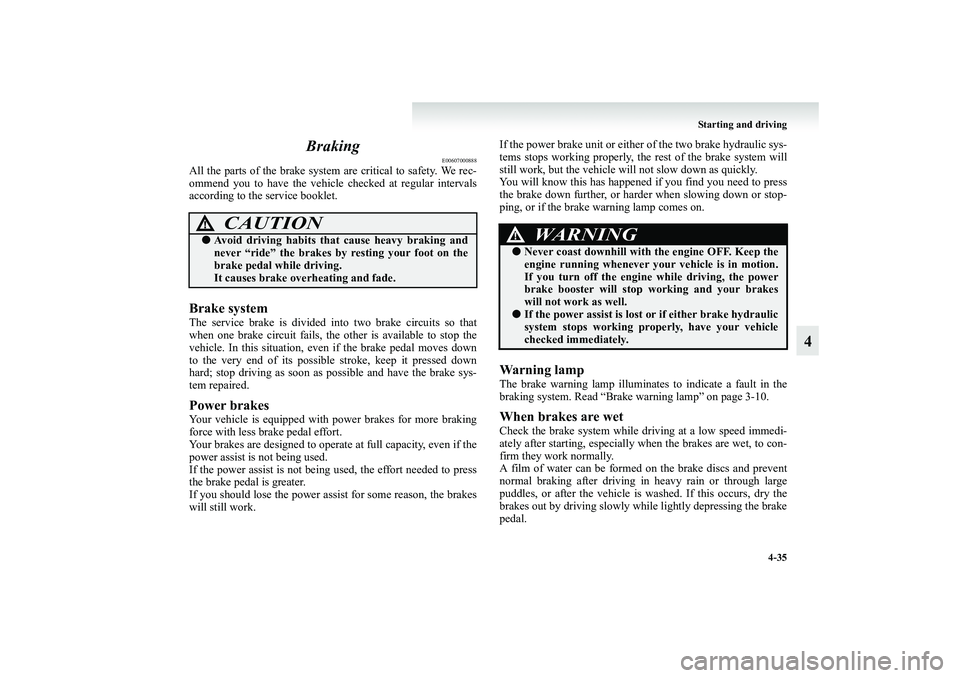
Starting and driving
4-35
4 Braking
E00607000888
All the parts of the brake system are critical to safety. We rec-
ommend you to have the vehicle checked at regular intervals
according to the service booklet.Brake systemThe service brake is divided into two brake circuits so that
when one brake circuit fails, the other is available to stop the
vehicle. In this situation, even if the brake pedal moves down
to the very end of its possible stroke, keep it pressed down
hard; stop driving as soon as possible and have the brake sys-
tem repaired.Power brakesYour vehicle is equipped with power brakes for more braking
force with less brake pedal effort.
Your brakes are designed to operate at full capacity, even if the
power assist is not being used.
If the power assist is not being used, the effort needed to press
the brake pedal is greater.
If you should lose the power assist for some reason, the brakes
will still work.If the power brake unit or either of the two brake hydraulic sys-
tems stops working properly, the rest of the brake system will
still work, but the vehicle will not slow down as quickly.
You will know this has happened if you find you need to press
the brake down further, or harder when slowing down or stop-
ping, or if the brake warning lamp comes on.
Wa r n i n g l a m pThe brake warning lamp illuminates to indicate a fault in the
braking system. Read “Brake warning lamp” on page 3-10.When brakes are wetCheck the brake system while driving at a low speed immedi-
ately after starting, especially when the brakes are wet, to con-
firm they work normally.
A film of water can be formed on the brake discs and prevent
normal braking after driving in heavy rain or through large
puddles, or after the vehicle is washed. If this occurs, dry the
brakes out by driving slowly while lightly depressing the brake
pedal.
CAUTION
!●Avoid driving habits that cause heavy braking and
never “ride” the brakes by resting your foot on the
brake pedal while driving.
It causes brake overheating and fade.
WARNING
!●Never coast downhill with the engine OFF. Keep the
engine running whenever your vehicle is in motion.
If you turn off the engine while driving, the power
brake booster will stop working and your brakes
will not work as well.●If the power assist is lost or if either brake hydraulic
system stops working properly, have your vehicle
checked immediately.
BK-XP08E1ENUK.en-uk.book Page 35 Monday, August 13, 2007 2:20 PM
Page 208 of 458
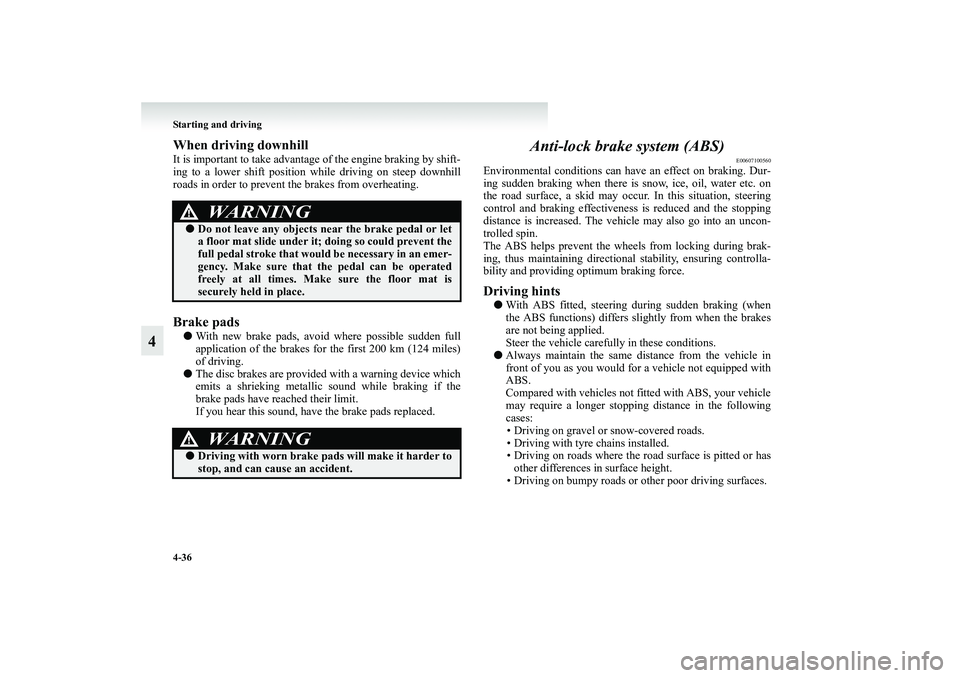
4-36 Starting and driving
4
When driving downhillIt is important to take advantage of the engine braking by shift-
ing to a lower shift position while driving on steep downhill
roads in order to prevent the brakes from overheating.Brake pads●With new brake pads, avoid where possible sudden full
application of the brakes for the first 200 km (124 miles)
of driving.
●The disc brakes are provided with a warning device which
emits a shrieking metallic sound while braking if the
brake pads have reached their limit.
If you hear this sound, have the brake pads replaced.
Anti-lock brake system (ABS)
E00607100560
Environmental conditions can have an effect on braking. Dur-
ing sudden braking when there is snow, ice, oil, water etc. on
the road surface, a skid may occur. In this situation, steering
control and braking effectiveness is reduced and the stopping
distance is increased. The vehicle may also go into an uncon-
trolled spin.
The ABS helps prevent the wheels from locking during brak-
ing, thus maintaining directional stability, ensuring controlla-
bility and providing optimum braking force.Driving hints●With ABS fitted, steering during sudden braking (when
the ABS functions) differs slightly from when the brakes
are not being applied.
Steer the vehicle carefully in these conditions.
●Always maintain the same distance from the vehicle in
front of you as you would for a vehicle not equipped with
ABS.
Compared with vehicles not fitted with ABS, your vehicle
may require a longer stopping distance in the following
cases:
• Driving on gravel or snow-covered roads.
• Driving with tyre chains installed.
• Driving on roads where the road surface is pitted or has
other differences in surface height.
• Driving on bumpy roads or other poor driving surfaces.
WARNING
!●Do not leave any objects near the brake pedal or let
a floor mat slide under it; doing so could prevent the
full pedal stroke that would be necessary in an emer-
gency. Make sure that the pedal can be operated
freely at all times. Make sure the floor mat is
securely held in place.
WARNING
!●Driving with worn brake pads will make it harder to
stop, and can cause an accident.
BK-XP08E1ENUK.en-uk.book Page 36 Monday, August 13, 2007 2:20 PM
Page 290 of 458

5-56 For pleasant driving
5
The lighter will automatically return to its original position
with a “click” when ready. Pull it out for use.
After use, insert the lighter to its original position in the socket.NOTE●Do not leave the cigarette lighter removed from its socket,
because the socket might become clogged by foreign
material and be short-circuited.1- Push all the way in.
CAUTION
!●Do not touch heating element or lighter housing,
hold the knob only to prevent burns.●Do not allow children to operate or play with the cig-
arette lighter as burns may occur.RHD
●Something is wrong with the cigarette lighter if it
does not pop back out within approximately 30 sec-
onds of being pushed in.
Leaving the cigarette lighter pushed in for an
extended period could cause fire. If it does not pop
out by itself, we recommend you to have it checked.●Do not leave the cigarette lighter pushed in or insert
the cigarette lighter from another vehicle. Other-
wise, the lighter may overheat and cause fire.●It is recommended that only the lighter be inserted
in its socket.
Use of “plug-in” type accessories may damage the
socket and result in poor retention of the lighter.●When the cigarette lighter socket is used as a power
source for an electric appliance, be sure that the
electric appliance operates at 12 V and has an elec-
tric capacity of 120 W or less. In addition, long use
of the electric appliance without running the engine
may run down the battery.
CAUTION
!
BK-XP08E1ENUK.en-uk.book Page 56 Monday, August 13, 2007 2:20 PM
Page 313 of 458
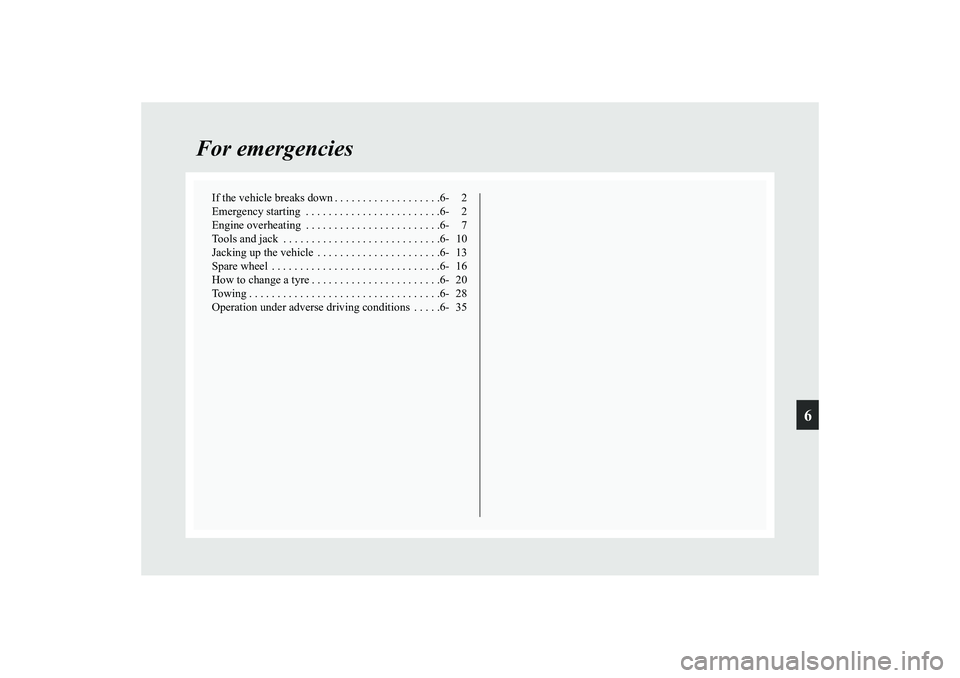
6
For emergencies
If the vehicle breaks down . . . . . . . . . . . . . . . . . . .6- 2
Emergency starting . . . . . . . . . . . . . . . . . . . . . . . .6- 2
Engine overheating . . . . . . . . . . . . . . . . . . . . . . . .6- 7
Tools and jack . . . . . . . . . . . . . . . . . . . . . . . . . . . .6- 10
Jacking up the vehicle . . . . . . . . . . . . . . . . . . . . . .6- 13
Spare wheel . . . . . . . . . . . . . . . . . . . . . . . . . . . . . .6- 16
How to change a tyre . . . . . . . . . . . . . . . . . . . . . . .6- 20
Towing . . . . . . . . . . . . . . . . . . . . . . . . . . . . . . . . . .6- 28
Operation under adverse driving conditions . . . . .6- 35
BK-XP08E1ENUK.en-uk.book Page 1 Monday, August 13, 2007 2:20 PM
Page 319 of 458
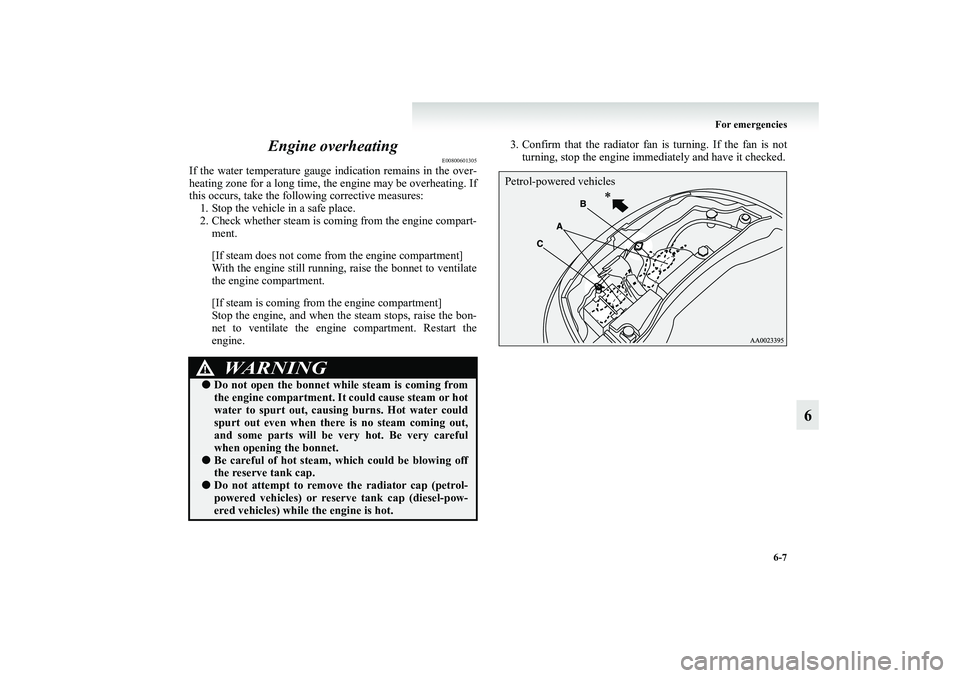
For emergencies
6-7
6 Engine overheating
E00800601305
If the water temperature gauge indication remains in the over-
heating zone for a long time, the engine may be overheating. If
this occurs, take the following corrective measures:
1. Stop the vehicle in a safe place.
2. Check whether steam is coming from the engine compart-
ment.
[If steam does not come from the engine compartment]
With the engine still running, raise the bonnet to ventilate
the engine compartment.
[If steam is coming from the engine compartment]
Stop the engine, and when the steam stops, raise the bon-
net to ventilate the engine compartment. Restart the
engine.3. Confirm that the radiator fan is turning. If the fan is not
turning, stop the engine immediately and have it checked.
WARNING
!●Do not open the bonnet while steam is coming from
the engine compartment. It could cause steam or hot
water to spurt out, causing burns. Hot water could
spurt out even when there is no steam coming out,
and some parts will be very hot. Be very careful
when opening the bonnet.●Be careful of hot steam, which could be blowing off
the reserve tank cap.●Do not attempt to remove the radiator cap (petrol-
powered vehicles) or reserve tank cap (diesel-pow-
ered vehicles) while the engine is hot.
Petrol-powered vehicles
BK-XP08E1ENUK.en-uk.book Page 7 Monday, August 13, 2007 2:20 PM
Page 347 of 458
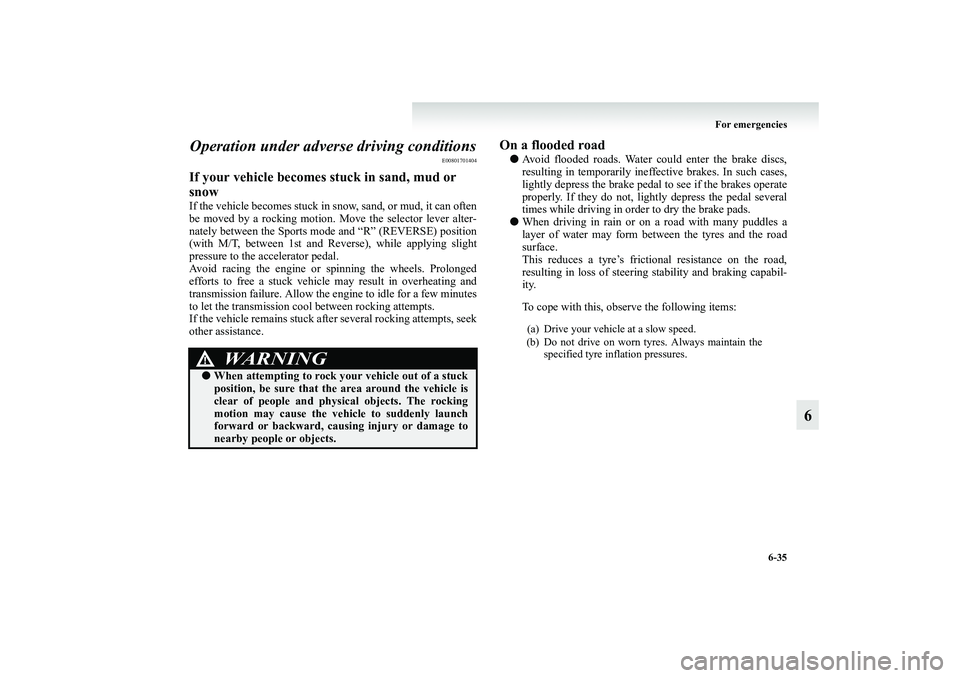
For emergencies
6-35
6 Operation under adverse driving conditions
E00801701404
If your vehicle becomes stuck in sand, mud or
snowIf the vehicle becomes stuck in snow, sand, or mud, it can often
be moved by a rocking motion. Move the selector lever alter-
nately between the Sports mode and “R” (REVERSE) position
(with M/T, between 1st and Reverse), while applying slight
pressure to the accelerator pedal.
Avoid racing the engine or spinning the wheels. Prolonged
efforts to free a stuck vehicle may result in overheating and
transmission failure. Allow the engine to idle for a few minutes
to let the transmission cool between rocking attempts.
If the vehicle remains stuck after several rocking attempts, seek
other assistance.
On a flooded road●Avoid flooded roads. Water could enter the brake discs,
resulting in temporarily ineffective brakes. In such cases,
lightly depress the brake pedal to see if the brakes operate
properly. If they do not, lightly depress the pedal several
times while driving in order to dry the brake pads.
●When driving in rain or on a road with many puddles a
layer of water may form between the tyres and the road
surface.
This reduces a tyre’s frictional resistance on the road,
resulting in loss of steering stability and braking capabil-
ity.
To cope with this, observe the following items:
WARNING
!●When attempting to rock your vehicle out of a stuck
position, be sure that the area around the vehicle is
clear of people and physical objects. The rocking
motion may cause the vehicle to suddenly launch
forward or backward, causing injury or damage to
nearby people or objects.
(a) Drive your vehicle at a slow speed.
(b) Do not drive on worn tyres. Always maintain the
specified tyre inflation pressures.
BK-XP08E1ENUK.en-uk.book Page 35 Monday, August 13, 2007 2:20 PM
Page 359 of 458
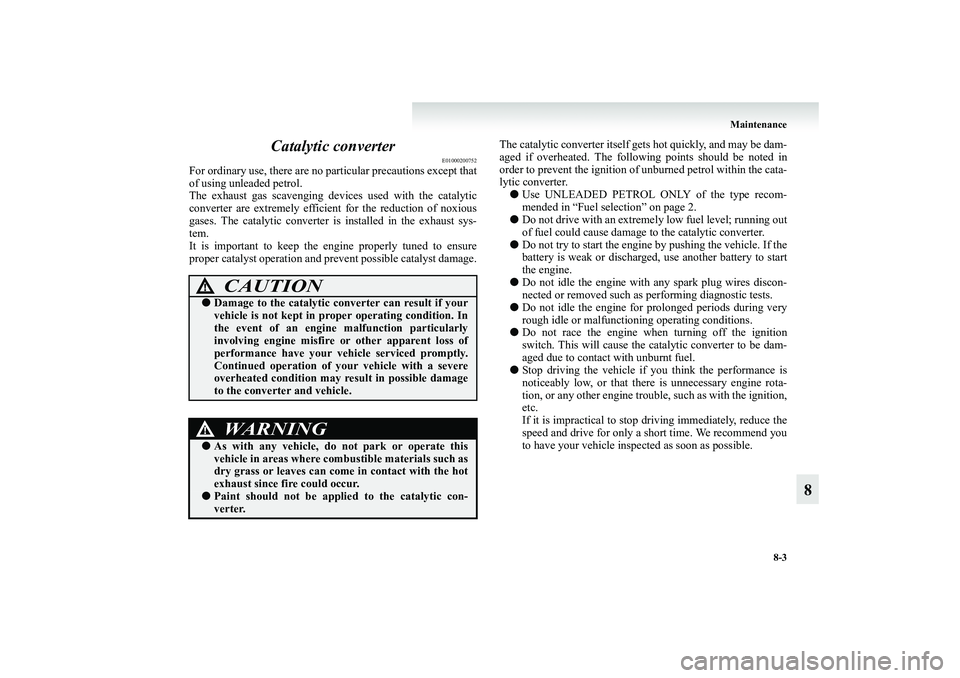
Maintenance
8-3
8 Catalytic converter
E01000200752
For ordinary use, there are no particular precautions except that
of using unleaded petrol.
The exhaust gas scavenging devices used with the catalytic
converter are extremely efficient for the reduction of noxious
gases. The catalytic converter is installed in the exhaust sys-
tem.
It is important to keep the engine properly tuned to ensure
proper catalyst operation and prevent possible catalyst damage.The catalytic converter itself gets hot quickly, and may be dam-
aged if overheated. The following points should be noted in
order to prevent the ignition of unburned petrol within the cata-
lytic converter.
●Use UNLEADED PETROL ONLY of the type recom-
mended in “Fuel selection” on page 2.
●Do not drive with an extremely low fuel level; running out
of fuel could cause damage to the catalytic converter.
●Do not try to start the engine by pushing the vehicle. If the
battery is weak or discharged, use another battery to start
the engine.
●Do not idle the engine with any spark plug wires discon-
nected or removed such as performing diagnostic tests.
●Do not idle the engine for prolonged periods during very
rough idle or malfunctioning operating conditions.
●Do not race the engine when turning off the ignition
switch. This will cause the catalytic converter to be dam-
aged due to contact with unburnt fuel.
●Stop driving the vehicle if you think the performance is
noticeably low, or that there is unnecessary engine rota-
tion, or any other engine trouble, such as with the ignition,
etc.
If it is impractical to stop driving immediately, reduce the
speed and drive for only a short time. We recommend you
to have your vehicle inspected as soon as possible.
CAUTION
!●Damage to the catalytic converter can result if your
vehicle is not kept in proper operating condition. In
the event of an engine malfunction particularly
involving engine misfire or other apparent loss of
performance have your vehicle serviced promptly.
Continued operation of your vehicle with a severe
overheated condition may result in possible damage
to the converter and vehicle.
WARNING
!●As with any vehicle, do not park or operate this
vehicle in areas where combustible materials such as
dry grass or leaves can come in contact with the hot
exhaust since fire could occur.●Paint should not be applied to the catalytic con-
verter.
BK-XP08E1ENUK.en-uk.book Page 3 Monday, August 13, 2007 2:20 PM
Page 360 of 458
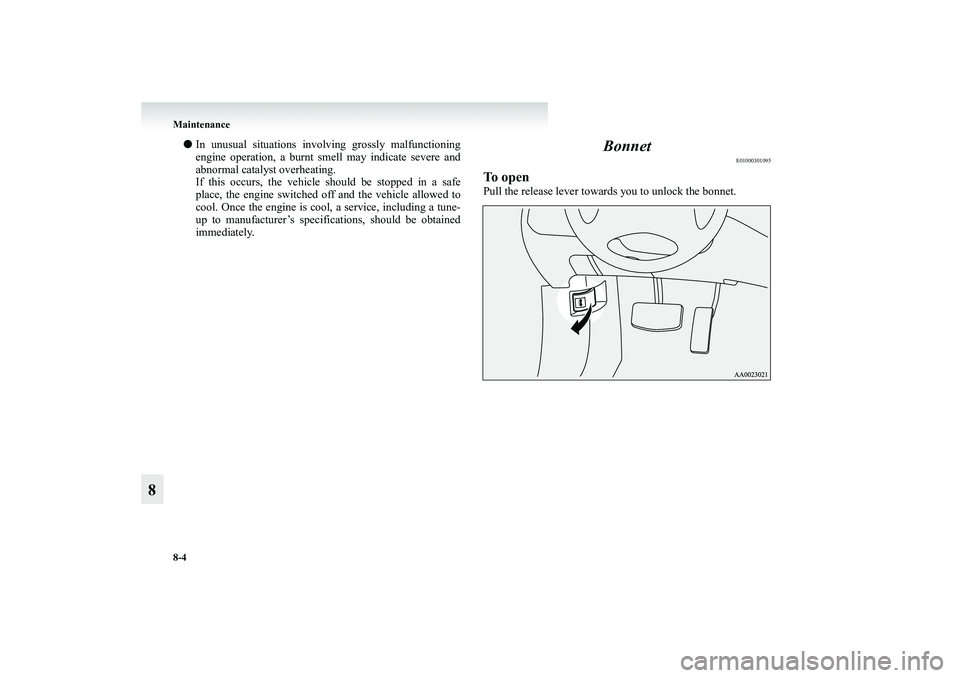
8-4 Maintenance
8
●In unusual situations involving grossly malfunctioning
engine operation, a burnt smell may indicate severe and
abnormal catalyst overheating.
If this occurs, the vehicle should be stopped in a safe
place, the engine switched off and the vehicle allowed to
cool. Once the engine is cool, a service, including a tune-
up to manufacturer’s specifications, should be obtained
immediately.
Bonnet
E01000301095
To open Pull the release lever towards you to unlock the bonnet.
BK-XP08E1ENUK.en-uk.book Page 4 Monday, August 13, 2007 2:20 PM